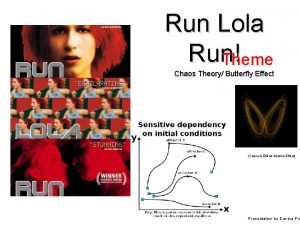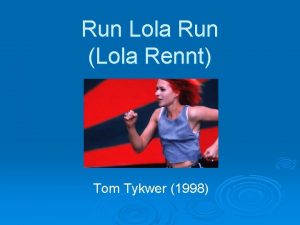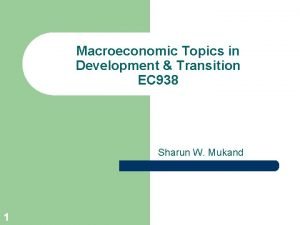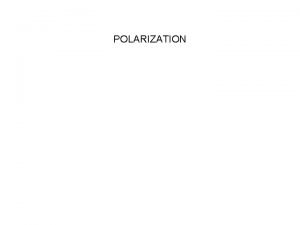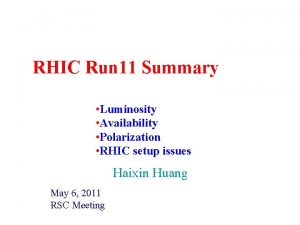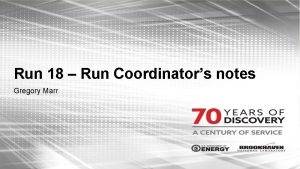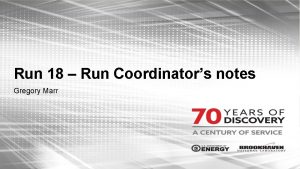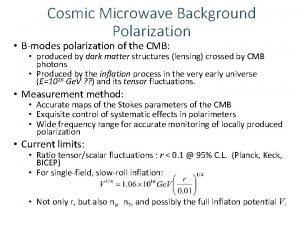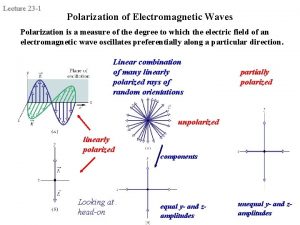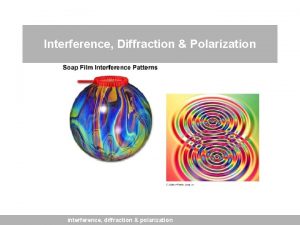Summary of Polarization Studies in Run 12 M











- Slides: 11

Summary of Polarization Studies in Run 12 M. Bai

Polarization Studies • Polarization losses during ramp – How much in total? – Where and how much? • Is 100 Ge. V ramp really polarization transparent? • Between 100 Ge. V and 255 Ge. V, polarization losses at the expected locations? • Polarization lifetime at store – What have we learned so far? – What dominates the polarization lifetime? – How to move forward? • Absolute polarization at injection

Polarization Lifetime at Store • Effect of Store Energy – A series of calculations of the stable spin direction at various energies around 250 Ge. V showed that 255 Ge. V has more vertically oriented stable spin directions, 4% (relative) for a beam with 30 mm-mrad emittance. With the agreement from both STAR and PHENIX, we set this year’s store energy to 255 Ge. V. Within the statistical error the observed polarization, lifetime was the same as in Run-11, and also as during 100 Ge. V operation. Courtesy of V. Ranjbar

Polarization Lifetime at Store • Effect of beam-beam and the 11/16 snake resonance – The beam-beam interaction introduces a large tune spread, which currently ranges from 0. 675 -0. 690. The direct contribution of beam interaction on spin motion is weak. But its effect on had not yet been studied experimentally. – Significant depolarization was observed during Run-9 when the vertical tune was placed on the 11/16 snake resonance. This resonance is only excited if there is an overlap of an imperfection with an intrinsic resonance. The rms orbit distortion reported by the Beam Position Monitors (BPMs) at store is as small as 20 μm. With such orbit distortions imperfection resonance can still be sizable and excite this even order spin resonance due to the offset in the BPMs.

Polarization Lifetime at Store • Effect of beam-beam and the 11/16 snake resonance – Two dedicated stores with no collisions were used to study the above effects. Each ring was filled with 56 bunches, and bunches of both rings were longitudinally separated. For both stores, the vertical tune in one of the rings was set to 11/16 = 0. 6875 and the vertical tune in the other ring was set to 0. 68. Within the statistical error of the p. C polarimeter the measurements show that the contribution of 11/16 snake resonance is not the dominant source of the polarization lifetime.

Polarization At Store • The p. C polarimeter data seems to indicate that the effect of 11/16 on polarization is less than 5% • orbit much better than 2009. To confirm, measure polarization with Qy=0. 6875 during ramp • polarization is dominated by beam-beam • Qy = 0. 68 in Blue seems to have no impact on polarization lifetime at all, as expected

Polarization At Store • 7/10 snake resonance is pretty visible at store, as expected • 11/16 snake resonance is not the dominant source of polarization lifetime for physics store • Data indicates the polarization lifetime is affected by beam-beam.

Polarization Lifetime at Store • Effect of spin tune – The spin tune was measured by exciting a single AC dipole at the vertical tune of 0. 49(0. 51). Then the spin tune was changed by ± 0. 01 with a change in the horizontal angle between the two snake spin rotation axes. Within the statistical error of the H-Jet measurement, no significant difference in the average store polarization was measured with different spin tunes. The spin tune measurement at store also shows a 0. 005 spin tune spread of both beams.

Polarization Losses during Ramp • Orbit effect on the last two strong intrinsic resonances on polarization – Vahid Ranjbar found a way to excite the spin harmonic with a certain closed orbit distortion. A dedicated ramp was carried out, showing a moderate depolarizing effect in one of the rings.

Polarization Losses during Ramp • Contribution from final beta squeeze – A dedicated ramp with a delayed final β*–squeeze was developed. Within the statistical error of the p. C polarimeter the polarization transmission efficiency was the same as for the regular ramp • Contribution from the rotator ramp – Polarization measurements were taken with the p. C polarimeter before and after the rotator ramp. The Yellow vertical tune was lowered below 0. 68 for the rotator ramp after observing a polarization loss during the rotator ramp.

Polarization Losses during Ramp • Effect of snake spin rotation angle – At the beginning of the run the snake currents in both rings were set to a values that give a spin rotation of 180 deg around an axis in the horizontal plan 135 deg from the beam direction, based on the existing snake magnetic model. , and this resulted in a 5% (absolute) gain in the Yellow ring. The snake spin rotation angle was also scanned during the run • Effect of spin tune during the ramp – The spin tune was changed between ± 0. 01 by changing the horizontal angle between the two snake spin rotation axes. Within the statistical error of the H-Jet measurement no difference in the average store polarization was measured after the ramp.
 Long run in perfect competition
Long run in perfect competition Run lola run themes
Run lola run themes Run lola run editing techniques
Run lola run editing techniques Short run vs long run economics
Short run vs long run economics Multirule plus
Multirule plus Perfect competition short run
Perfect competition short run Brigitta olsen
Brigitta olsen Lola rennt filmanalyse
Lola rennt filmanalyse Paradigm shift from women studies to gender studies
Paradigm shift from women studies to gender studies Ap psychology unit 14
Ap psychology unit 14 Deindividuation
Deindividuation Dispositional attribution
Dispositional attribution

